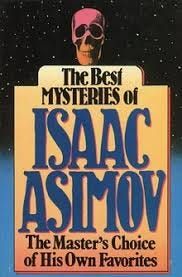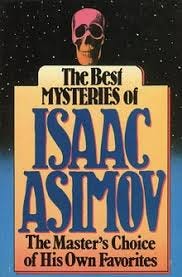Readers unfamiliar with "Halloween" (1975) by Isaac Asimov may prefer to read these notes only after reading the story.
From the introduction to The Best Mysteries of Isaac Asimov (1986):
....almost every mystery story I write belongs to the “armchair detective” variety. Our hero listens to a puzzling story of some kind that seems to have no solution and, taking into account only what he is told, comes up with the answer in so cogent a fashion that every other character in the story (and the reader, too) is at once convinced of its legitimacy.
Naturally, the story under such conditions must be a fair one. The detective must know only what the reader knows so that there is nothing to stop a particularly ingenious reader from beating the detective to the solution. And, indeed, my stories openly challenge the reader to do so; and often enough, the reader does.
"Halloween" (1975) is a fairly-clued locked-room mystery. The locked room is a modern-day big city hotel. The culprit had a day to find a hiding place for a stolen object. Where is the needle in the haystack?
“Could there be possible danger to the individual holding it?”
“None if it’s left in its case. If you took it out, there would be damage eventually to anyone coming in contact with it.”
“I could see where public alarm would be justified,” Haley said.
Sanderson frowned. “But it proves nothing. It was a mistake that will never happen again and, in any case, the alarm system worked. We were after him at once. If he hadn’t managed to get to this hotel; if we didn’t fear alarming the people here…”
“Why didn’t you inform the Bureau at once?”
“If we could have gotten him ourselves…” Sanderson mumbled.
“Then the whole thing could have been hidden, even from the Bureau. Mistakes and all.”
“Well…”
“But you did inform us in the end. After he died. I take it, therefore, you don’t have the plutonium?”
Sanderson’s eyes drifted furtively away from Haley’s steady glance. “No, we don’t.” Then defensively, “We couldn’t operate too openly. There were thousands of people here and if the notion arose that there was trouble—if it were pinned to the station…”
“Then you would have lost and he would have won, even if you caught him and retrieved the plutonium. I understand that. How long was he here then?” Haley looked at his watch. “It’s 3:57 A.M. now.”
“All day. It was only when it got late enough to allow us to work more openly that we trapped him on the stairs. We tried to rush him and he tried to run. He slipped—hit his head against the railing, after tumbling a flight, and fractured his skull.”
The Halloween connection is slightly abstract, but perfectly logical as the missing puzzle piece.
Asimov is apparently a reading preference acquired early or never. In my teens I read horror and thrift store copies of Signet Classics. I sneered inwardly at science fiction, though I read Wells and Colin Wilson with pleasure in high school.
More accurately, I sneered at U.S. science fiction of what used to be called the Golden Age: its aesthetic banality, patriotism, blah, blah, blah.
It's not that I have a different opinion today. But I have read with pleasure stories in several anthologies edited by David G. Hartwell that cover the period.
But Asimov? I found "Nightfall" (theme: The masses are ignorant and destructive) interesting but humorless. Humorlessness seems to be a hallmark of Asimov's fiction; at least Heinlein and Clarke seemed to be enjoying themselves.
Jay





